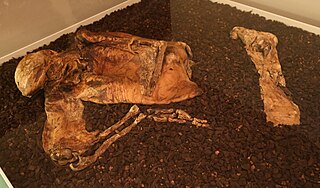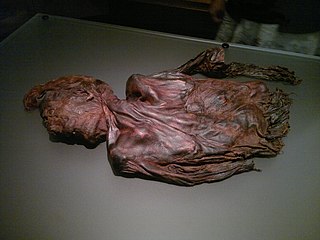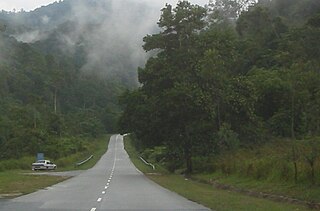
Red marked lightly fragmented bones, blue marked heavily fragmented bones
Stoneyisland Man is the name given to a bog body discovered in the Stoneyisland Bog, Gortanumera, County Galway, Ireland on 13 May 1929.

Stoneyisland Man is the name given to a bog body discovered in the Stoneyisland Bog, Gortanumera, County Galway, Ireland on 13 May 1929.
Turf-cutters James Dolphin, Thomas Rodgers and John Spain uncovered a human skeleton while working on Dolphin's bank, located towards the centre of Stoneyisland Bog. It was first thought to be the remains of a Mr. Ward of Ballyshrule who had been missing for some time, but it was later revealed to be over five thousand years old.
"It was found lying on its back within a few inches of the marl, at the base of the bog, beneath 10 feet (300 cm) of uncut turf. The skeleton was intact with the arms outstretched at right angles to the body. No implements were found with the skeleton, but Mr. Dolphin said at the time that they had previously found tree stumps and ashes at higher depths in the bog. He also claimed to have found a dugout canoe at a depth of 5 feet (150 cm), while cutting turf in another part of the bog on a previous occasion. Mr. T. Shea, who was in charge of a section of the Ordnance Survey, operating in the district at the time, examined the remains. He excavated the skeleton and had it examined by Professor Shea of the Anatomical Museum, University College, Galway." [1]
Professor Shea's conclusions were that "the body [sic] had not sunk slowly down from an originally higher level in the bog, but was lying in the position and at the level where it originally lay". He believed that the outstretched arms indicated that the person had drowned, sank to the bottom of what was then a lake, and the bog grew over it. [1]
His further conclusions were that the body was of a man, aged about forty, 5 feet 2 inches (1.57 m) in height. "The lower jaw and teeth, and a large number of the limbs bones were peculiar to prehistoric skeletons in Western Europe. The period of the skeleton was further determined by the degree of flattening of some of the arm and leg bones which are characteristic of skeletons of Neolithic man." [1]
Pollen and peat analysis dated the remains to sometime after 4500 BC. Several radiocarbon datings dated the remains between 3320–3220 BC. [2]

Lindow Man, also known as Lindow II and as Pete Marsh, is the preserved bog body of a man discovered in a peat bog at Lindow Moss near Wilmslow in Cheshire, North West England. The remains were found on 1 August 1984 by commercial peat cutters. Lindow Man is not the only bog body to have been found in the moss; Lindow Woman was discovered the year before, and other body parts have also been recovered. The find was described as "one of the most significant archaeological discoveries of the 1980s" and caused a media sensation. It helped invigorate the study of British bog bodies, which had previously been neglected.

A bog body is a human cadaver that has been naturally mummified in a peat bog. Such bodies, sometimes known as bog people, are both geographically and chronologically widespread, having been dated to between 8000 BC and the Second World War. The unifying factor of the bog bodies is that they have been found in peat and are partially preserved; however, the actual levels of preservation vary widely from perfectly preserved to mere skeletons.

Lansing Man is the name commonly given to a collection of human remains dug up in the loess banks of the Missouri River near Lansing, Kansas in February 1902. The remains were found in the process of digging a cellar tunnel for fruit storage on the farm of Martin Concannon. The human remains found consisted of a skull and several large bones from an adult male, as well as a child's mandible.

The Windover Archeological Site is a Middle Archaic archaeological site and National Historic Landmark in Brevard County near Titusville, Florida, United States on the central east coast of the state. Windover is a muck pond where skeletal remains of 168 individuals were found buried in the peat at the bottom of the pond. The skeletons were well preserved because of the peat. In addition, remarkably well-preserved brain tissue has been recovered from 91 skulls from the site. DNA from the brain tissue has been sequenced. The collection of human skeletal remains and artifacts recovered from Windover Pond represent among the largest finds of each type from the Archaic Period. It is considered one of the most important archeological sites ever excavated.
Sawyl Penuchel or Ben Uchel, also known as Samuil Penissel, was a British king of the sub-Roman period, who appears in old Welsh genealogies and the Welsh Triads.

Clonycavan Man is the name given to a well-preserved Iron Age bog body found in Clonycavan, Ballivor, County Meath, Ireland in March 2003. The body shows signs of having been murdered. Theories around the meanings and manner of his death vary.

Lenggong or Lenggong Valley is a geographical area defined by the mountain ranges of Bintang in the west and Titiwangsa to its east. It is a rural area, with small kampongs surrounded by green vegetation and limestone hills with numerous caves.
Lindow Woman and Lindow I are the names given to the partial remains of a female bog body, discovered in a peat bog at Lindow Moss, near Wilmslow in Cheshire, England, on 13 May 1983 by commercial peat-cutters. The remains were largely a skull fragment, which was missing its jaw, but with soft tissue and hair attached. The remains were subsequently dated to the Roman period. The remains became more technically known as Lindow I after the discovery of other remains in the same bog, which were identified as Lindow Man or Lindow II in 1984 and Lindow III in 1987.

Denghoog is a Neolithic passage grave dating from around 3000 BC on the northern edge of Wenningstedt-Braderup on the German island of Sylt. The name Denghoog derives from the Söl'ring Deng (Thing) and Hoog (Hill).
The Niedertiefenbach tomb is a megalithic tomb located near Beselich-Niedertiefebach in Hesse, Germany. It belongs to the Wartberg culture of the Central European Later Neolithic. It is of special importance in Central European prehistory because of the sequence of collective burial layers contained within it.
The Koelbjerg Man, formerly known as "Koelbjerg Woman", is the oldest known bog body and also the oldest set of human bones found in Denmark, dated to the time of the Maglemosian culture about 8000 BC. His remains are on display at the Møntergården Museum in Odense, Denmark.
Kilnamadoo or Kilnamaddoo is a townland in County Fermanagh, Northern Ireland. It is situated within the civil parish of the area of Boho, as well as Fermanagh and Omagh district.
The Borremose bodies are three bog bodies that were found in the Borremose peat bog in Himmerland, Denmark. Recovered between 1946 and 1948, the bodies of a man and two women have been dated to the Nordic Bronze Age. In 1891, the Gundestrup cauldron was found in a nearby bog.

Jehohanan was a Judean man sentenced to death by crucifixion sometime in the 1st century CE. His ossuary was found in 1968 when building contractors working in Giv'at ha-Mivtar accidentally uncovered a Jewish tomb. The stone ossuary had the Hebrew inscription of "Jehohanan the son of Hagkol".
The Derrybrien Necklace was an Irish archaeological discovery dated to 800-700 BC.
Shiraho Saonetabaru Cave Ruins is a paleoanthropological site located on Ishigaki Island of the Yaeyama Islands in Japan. Shiraho Saonetabaru is a limestone cave.

Amcotts Moor Woman is the name given to a bog body discovered in 1747 in a bog near Amcotts, Lincolnshire, England, who lived sometime between A.D. 200 and 400.

Knap Hill lies on the northern rim of the Vale of Pewsey, in northern Wiltshire, England, about a mile north of the village of Alton Priors. At the top of the hill is a causewayed enclosure, a form of Neolithic earthwork that was constructed in England from about 3700 BC onwards, characterized by the full or partial enclosure of an area with ditches that are interrupted by gaps, or causeways. Their purpose is not known: they may have been settlements, or meeting places, or ritual sites of some kind. The site has been scheduled as an ancient monument.

The Barum Woman, formerly known as The Bäckaskog Woman (Bäckaskogskvinnan), is one of the best-preserved skeletal finds in Sweden from the Maglemosian culture of the Mesolithic. She was found in 1939 in Barum and is now in the Swedish History Museum in Stockholm.

Angeles Mesa Skeletons or Haverty Skeletons are two common names for permineralized prehistoric human remains comprising eight individuals that were found in loose sands and sandy clays at the base of the Baldwin Hills between Culver City and Los Angeles in Southern California in 1924. Angeles Mesa is the neighborhood where they were found; Haverty Construction Company was the business that initially uncovered the site.
dewiki_dim:1000 53°5′2.5″N8°17′41″W / 53.084028°N 8.29472°W